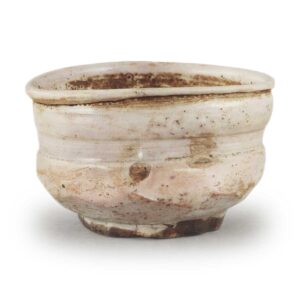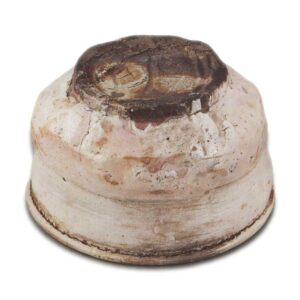

Height: 7.5-8.0cm
Diameter: 11.2-13.0cm
Foot diameter: 7.3-7.7cm
Height: 0.7-0.9cm
It was owned by Furuta Oribe, and is therefore called Furuta Kora, and it is a famous tea bowl that has been famous for a long time as the best tea bowl in Gosomaru.
There are two types of Gosomaru tea bowls: plain white tea bowls called Shiro Gosomaru, and tea bowls with black patterns drawn in black paint on a white background, which are called Kuro Hakeme. Of the black brush-painted Goshomaru, the one in the Fujita Museum is the best, and of the white ones, the one by Furuta Koryo is the best. The Furuta Koryo is a famous bowl that stands out from the crowd in terms of its elegant shape, rim, tight body and finish, and in particular, the way the foot ring is made is extraordinary. Even though it is extraordinary, it was made by a Korean potter whose name is unknown, and it was made by carelessly scraping it with a spatula. Compared to other Gosomaru, the foot is solid, and the free scraping has an elegance that is endless.
The body is a hard, tightly-fired body that is close to porcelain, and it is covered in a transparent white glaze on the inside and outside, and there are no cracks. The bottom and reverse are also glazed, but the tatami mat is unglazed, and only the inside is glazed. There are rough cracks like Shino ware. The firing is slightly oxidized and slightly sweet, and because the glaze has not yet dissolved well, there are some areas that have become cloudy white, and there are also areas with a faint reddish mottled pattern, which is commonly called “mottled”, and in particular, the waist is a light reddish color all over.
It was made on a potter’s wheel, but the shape is based on the Oribe kutsu-gata (shoe-shaped) form. The rim is twisted outwards and rounded, and there is a certain charm in the way the thick and thin parts alternate. The body is held together while being spun on the potter’s wheel with a flat plate-like object, so it is indented in a band-like shape. The waist is plump and full, but from the waist to the foot there is a rough pattern all over the surface. The pattern is added freely and carelessly, so there is nothing deliberate about it, and this is the mysterious charm of this tea bowl. Of the many Korean tea bowls, there are not many that have such a solid and dignified foot ring, and the random-looking brush marks are the most attractive feature of this tea bowl.
Although it is plain white, the body has various changes due to drips of glaze, areas where the glaze does not adhere, fingerprints, and sticking, adding various scenery to the interesting finish of the firing. The only flaws are a few chips on the waist and foot, and there is no single crack on the rim, making this a tea bowl that is almost perfectly intact.
The accompanying bag is plain white satin with a large arabesque pattern, the inner box is paulownia wood, and on the front of the lid is a note written by Kobori Enshu that reads “Furuta Koryo”. The outer box is also paulownia wood. There is also one other accompanying note.
It is said that it was once owned by the tea master Furuta Oribe, and then passed down to the wealthy merchant Fuyuki family in Fukagawa, Edo, and was also owned by the calligrapher Ryozen for a time, but when he ran out of money for his pleasures, he pawned it to the Kemban Daikokuya in Yoshiwara, and it ended up in the hands of the fan maker Uemon. There is also a story that, around the time of the Tenmei era, Konoike Rosetsu heard about this and sent his regular tool dealer Kaga Sakutei to Edo to acquire it, and that he succeeded in doing so after a night of debauchery.
This tea bowl was not included in the Konoike family’s auction in 1942, but after the war it left the Konoike family and is now in the collection of a certain family in Osaka. Listed in the Taisho Meiki Kan.



